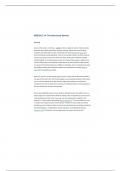MODULE 19: The Nonvisual Senses
Hearing
Like our other senses, our hearing— audition—helps us adapt and survive. Hearing provides
information and enables relationships. Hearing humanizes: People seem more thoughtful,
competent, and likable when we hear, not just read, their words (Schroeder & Epley, 2015,
2016). And hearing is pretty spectacular. It lets us communicate invisibly—we shoot unseen air
waves across space and receive the same from others. Hearing loss is therefore the great
invisible disability. To not catch someone’s name, to not grasp what someone is asking, and to
miss the hilarious joke is to be deprived of what others know, and sometimes to feel excluded.
As a person with inherited hearing loss, I [DM] know the feeling, and can understand why adults
with significant hearing loss experience increased risk of depression and anxiety (Blazer &
Tucci, 2019; Scinicariello et al., 2019).
Most of us, however, can hear a wide range of sounds, and the ones we hear best are those in
the range of the human voice. With normal hearing, we are remarkably sensitive to faint sounds,
such as a child’s whimper. (If our ears were only slightly more sensitive, we would hear a
constant hiss from the movement of air molecules.) Our distant ancestors’ survival depended on
this keen hearing when hunting or being hunted.
We are also remarkably attuned to sound variations. Among thousands of possible voices, we
easily recognize an unseen friend’s. Moreover, hearing is fast. “It might take you a full second to
notice something out of the corner of your eye, turn your head toward it, recognize it, and
respond to it,” notes auditory neuroscientist Seth Horowitz (2012). “The same reaction to a new
or sudden sound happens at least 10 times as fast.” A fraction of a second after such events
stimulate your ear’s receptors, millions of neurons have simultaneously coordinated in extracting
the essential features, comparing them with past experience, and identifying the stimulus
(Freeman, 1991). For hearing, as for our other senses, we wonder: How do we do it?
, The Stimulus Input: Sound Waves
LOQ 19-1
What are the characteristics of the air pressure waves that we hear as sound?
Draw a bow across a violin, and you will unleash the energy of sound waves. Air molecules,
each bumping into the next, create waves of compressed and expanded air, like the ripples on a
pond circling out from a tossed stone. As we swim in our ocean of moving air molecules, our
ears detect these brief air pressure changes.
Like light waves, sound waves vary in shape (FIGURE 19.1). The height, or amplitude, of sound
waves determines their perceived loudness. Their frequency (measured in hertz) determines
the pitch (the high or low tone) we experience. Long waves have low frequency—and low pitch.
Short waves have high frequency—and high pitch. Sound waves produced by a soprano are
much shorter and faster than those produced by a baritone singer.
FIGURE 19.1 The physical properties of waves (a) Waves vary in wavelength (the distance
between successive peaks). Frequency, the number of complete wavelengths that can pass a




